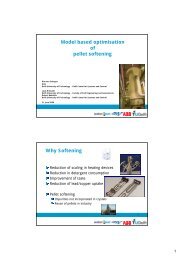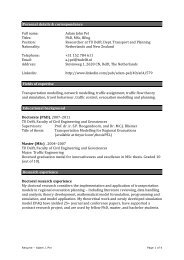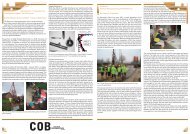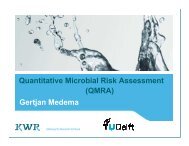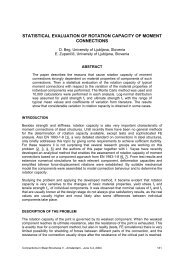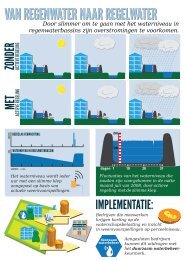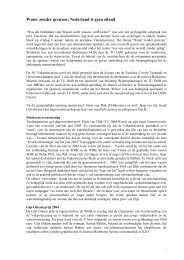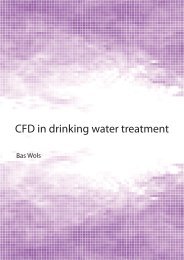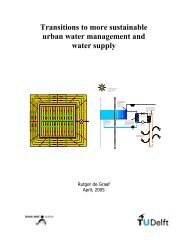Structural Design of Pavements PART VI Structural ... - TU Delft
Structural Design of Pavements PART VI Structural ... - TU Delft
Structural Design of Pavements PART VI Structural ... - TU Delft
Create successful ePaper yourself
Turn your PDF publications into a flip-book with our unique Google optimized e-Paper software.
23<br />
The following sections are discriminated.<br />
Section<br />
Locations<br />
1 0.05-0.1-0.15<br />
2 0.2-0.25-0.3<br />
3 0.35-0.4-0.45<br />
4 0.5-0.55-0.6<br />
5 0.65 this is a single point clearly visible in the SCI plot<br />
6 0.7-0.75-0.8-0.85-0.9-0.95<br />
7 1 this is a single point clearly visible in the SCI plot<br />
8 1.05-1.1-1.05<br />
9 1.1-1.15-1.2-1.25-1.3-1.35-1.4-1.45<br />
10 1.5 this is a single point clearly visible in the SCI plot<br />
11 1.55-1.6<br />
12 1.65-1.7-1.75-1.8-1.85-1.9-1.95-2<br />
By means <strong>of</strong> the cumsum method we have arrived to a set <strong>of</strong> successive sub-sections, each<br />
<strong>of</strong> them having more or less a certain flexural stiffness. Now it is interesting to determine if we<br />
can combine a few sections. If this is possible we would reduce the work load. The question<br />
now is how to achieve that.<br />
If we compare the slopes <strong>of</strong> the different sections we notice that the slopes <strong>of</strong> sections 2, 4<br />
and 12 are about the same. This means that they can be taken as one section in the further<br />
analysis. This also holds for sections 1 and 6, so also these can be treated as one section.<br />
The same is true for sections 3, 8 and 11.<br />
Then we have a look to the single points that are discriminated and we try to assign them to a<br />
particular subsection. We observe that location 0.65 is clearly an isolated peak value and<br />
should therefore be treated as such. Location 1 however could very well be combined with<br />
section 2. Also location 1.5 is better treated as a single point.<br />
All in all we arrive to the subsections given below.<br />
Section<br />
Locations<br />
1 0.05-0.1-0.15 and 0.7-0.75-0.8-0.85-0.9-0.95<br />
2 0.2-0.25-0.3 and 0.5-0.55-0.6 and 1.65-1.7-1.75-1.8-1.85<br />
-1.9-1.95-2 and 1<br />
3 0.35-0.4-0.45 and 1.05-1.1-1.15 and 1.55-1.6<br />
4 0.65<br />
5 1.1-1.15-1.2-1.25-1.3-1.35-1.4-1.45<br />
6 1.5<br />
The statistics <strong>of</strong> the sub-sections mentioned above are tabulated below.<br />
Section Mean Value SCI Standard Deviation SCI Var. Coeff.<br />
1 420 111 26%<br />
2 175 65 37%<br />
3 494 62 13%<br />
4 962<br />
5 423 77 18%<br />
6 96<br />
As one will notice, rather high values for the coefficient <strong>of</strong> variation are still obtained for<br />
sections 1 and 2. We have to look then in table 2, in order to find out what the possible<br />
reasons for this could be. By doing so we observe that location 0.8 doesn’t really fit in section<br />
1 and should better be moved to section 2. The high variation in section 2 is probably caused<br />
by the inclusion <strong>of</strong> locations 1.7 and 1.75; also location 1.9 could contribute to the high<br />
variation. Therefore it is suggested to move location 1.9 to section 1 and to combine locations<br />
1.7 and 1.75 with location 1.5. We then obtain the sections and summary statistics as shown<br />
in table 3.<br />
As one can observe a better result in terms <strong>of</strong> lower coefficients <strong>of</strong> variation are obtained. The<br />
division in subsections as shown in table 3 will be used for further treatment.



